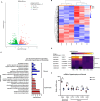The unique hypertrophic and fibrotic features of neonatal right ventricle in response to pressure overload
- PMID: 40394014
- PMCID: PMC12092643
- DOI: 10.1038/s41598-025-01427-y
The unique hypertrophic and fibrotic features of neonatal right ventricle in response to pressure overload
Abstract
Pediatric heart failure (HF) research remains in its infancy partly due to the lack of neonatal rat/mouse models of HF. The aim of the study is to introduce a neonatal rat/mouse model of right ventricular (RV) pressure overload (RVPO), a significant cause of pediatric HF, and to uncover the molecular features of RVPO-induced RV hypertrophy and fibrosis-the two most important transitional pathological states between normal and dysfunctional RV. Neonatal rat/mouse model of RVPO was established by pulmonary artery banding (PAB) surgery on postnatal day 1(P1) and confirmed by echocardiography and morphological examination on P7. Bulk RNA and single-cell RNA sequencing was performed on RV tissues, along with bulk RNA sequencing on RV cardiomyocytes, to screen a range of key genes and signaling pathways that are upregulated and that play critical roles in adult hypertrophy and fibrosis. The sequencing results were further verified by qRT-PCR and histological staining. Most of the pathways and associated genes, such as oxidative stress, inflammation, phosphodiesterase, proteasome, protein kinase, transforming growth factor, and angiotensin were not changed or downregulated in the neonatal RVPO model. This study reveals the unique features of hypertrophy and fibrosis in the neonatal RV in response to pressure overload, which partly explains why adult-effective anti-HF drugs fail to treat pediatric HF. More importantly, single-cell RNA sequencing data of the neonatal RV with pressure overload were documented, providing an important reference for future basic or clinical investigations on pediatric RV failure.
Keywords: Pediatric; Pressure overload; Right heart failure; Right ventricle; Single-cell sequencing.
© 2025. The Author(s).
Conflict of interest statement
Declarations. Competing interests: The authors declare no competing interests.
Figures







References
-
- Daly, K. P. & Zuckerman, W. A. The burden of pediatric heart failure that Lies just under the surface. J. Am. Coll. Cardiol.79 (19), 1929–1931. 10.1016/j.jacc.2022.03.339 (2022). - PubMed
-
- Amdani, S. et al. Burden of pediatric heart failure in the united States. J. Am. Coll. Cardiol.79 (19), 1917–1928. 10.1016/j.jacc.2022.03.336 (2022). - PubMed
-
- Siegel, R. L., Miller, K. D., Fuchs, H. E., Jemal, A. & Cancer statistics. CA Cancer J Clin.72(1), 7–33. 10.3322/caac.21708 (2022). - PubMed
-
- Rossano, J. W. et al. International society for heart and lung transplantation. The international thoracic organ transplant registry of the international society for heart and lung transplantation. Twenty-second pediatric heart transplantation report – 2019; focus theme: donor and recipient size match. J. Heart Lung Transpl.38 (10), 1028–1041. 10.1016/j.healun.2019.08.002 (2019). - PMC - PubMed
MeSH terms
Grants and funding
- No. 2022020405/Ningbo Top Medical and Health Research Program
- 2024YK1568/Medical and Health Technology Plan Projects of Zhejiang
- PPXK2024-06/Ningbo Medical and Health Brand Discipline
- PPXK2024-06/Ningbo Medical and Health Brand Discipline
- Nos. 82370310 and 82270314/National Natural Science Foundation of China
LinkOut - more resources
Full Text Sources
Medical
Research Materials
Miscellaneous

